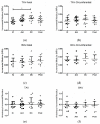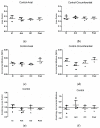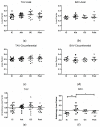Investigation on the Regional Loss Factor and Its Anisotropy for Aortic Aneurysms
- PMID: 28773988
- PMCID: PMC5457275
- DOI: 10.3390/ma9110867
Investigation on the Regional Loss Factor and Its Anisotropy for Aortic Aneurysms
Abstract
An aortic aneurysm is a lethal arterial disease that mainly occurs in the thoracic and abdominal regions of the aorta. Thoracic aortic aneurysms are prevalent in the root/ascending parts of the aorta and can lead to aortic rupture resulting in the sudden death of patients. Understanding the biomechanical and histopathological changes associated with ascending thoracic aortic aneurysms (ATAAs), this study investigates the mechanical properties of the aorta during strip-biaxial tensile cycles. The loss factor-defined as the ratio of dissipated energy to the energy absorbed during a tensile cycle-the incremental modulus, and their anisotropy indexes were compared with the media fiber compositions for aneurysmal (n = 26) and control (n = 4) human ascending aortas. The aneurysmal aortas were categorized into the aortas with bicuspid aortic valves (BAV) and tricuspid aortic valves (TAV). The strip-biaxial loss factor correlates well with the diameter of the aortas with BAV and TAV (for the axial direction, respectively, R² = 0.71, p = 0.0022 and R² = 0.54, p = 0.0096). The loss factor increases significantly with patients' age in the BAV group (for the axial direction: R² = 0.45, p = 0.0164). The loss factor is isotropic for all TAV quadrants, whereas it is on average only isotropic in the anterior and outer curvature regions of the BAV group. The results suggest that loss factor may be a useful surrogate measure to describe the histopathology of aneurysmal tissue and to demonstrate the differences between ATAAs with the BAV and TAV.
Keywords: age; aortic aneurysm; aortic diameter; collagen and elastin; loss factor; strip-biaxial tensile test.
Conflict of interest statement
The authors declare no conflict of interest.
Figures












Similar articles
-
Evaluating ascending aortic aneurysm tissue toughness: Dependence on collagen and elastin contents.J Mech Behav Biomed Mater. 2016 Dec;64:262-71. doi: 10.1016/j.jmbbm.2016.08.006. Epub 2016 Aug 6. J Mech Behav Biomed Mater. 2016. PMID: 27526037
-
Differential tensile strength and collagen composition in ascending aortic aneurysms by aortic valve phenotype.Ann Thorac Surg. 2013 Dec;96(6):2147-54. doi: 10.1016/j.athoracsur.2013.07.001. Epub 2013 Sep 7. Ann Thorac Surg. 2013. PMID: 24021768 Free PMC article.
-
Biomechanics of Aortic Dissection: A Comparison of Aortas Associated With Bicuspid and Tricuspid Aortic Valves.J Am Heart Assoc. 2020 Aug 4;9(15):e016715. doi: 10.1161/JAHA.120.016715. Epub 2020 Jul 28. J Am Heart Assoc. 2020. PMID: 32750292 Free PMC article.
-
Endothelial/Epithelial Mesenchymal Transition in Ascending Aortas of Patients With Bicuspid Aortic Valve.Front Cardiovasc Med. 2019 Dec 17;6:182. doi: 10.3389/fcvm.2019.00182. eCollection 2019. Front Cardiovasc Med. 2019. PMID: 31921896 Free PMC article. Review.
-
Molecular Regulation of Arterial Aneurysms: Role of Actin Dynamics and microRNAs in Vascular Smooth Muscle.Front Physiol. 2017 Aug 10;8:569. doi: 10.3389/fphys.2017.00569. eCollection 2017. Front Physiol. 2017. PMID: 28848449 Free PMC article. Review.
Cited by
-
What Are the Biomechanical Properties of an Aortic Aneurysm Associated with Quadricuspid Aortic Valve?J Clin Med. 2022 Aug 20;11(16):4897. doi: 10.3390/jcm11164897. J Clin Med. 2022. PMID: 36013136 Free PMC article.
-
Inhibition of miR-155 attenuates abdominal aortic aneurysm in mice by regulating macrophage-mediated inflammation.Biosci Rep. 2018 May 8;38(3):BSR20171432. doi: 10.1042/BSR20171432. Print 2018 Jun 29. Biosci Rep. 2018. PMID: 29459426 Free PMC article.
-
3D printed ascending aortic simulators with physiological fidelity for surgical simulation.BMJ Simul Technol Enhanc Learn. 2021 Jun 21;7(6):536-542. doi: 10.1136/bmjstel-2021-000868. eCollection 2021. BMJ Simul Technol Enhanc Learn. 2021. PMID: 35520974 Free PMC article.
-
Local variations in material and structural properties characterize murine thoracic aortic aneurysm mechanics.Biomech Model Mechanobiol. 2019 Feb;18(1):203-218. doi: 10.1007/s10237-018-1077-9. Epub 2018 Sep 24. Biomech Model Mechanobiol. 2019. PMID: 30251206 Free PMC article.
-
A Comprehensive Review on the Viscoelastic Parameters Used for Engineering Materials, Including Soft Materials, and the Relationships between Different Damping Parameters.Sensors (Basel). 2024 Sep 23;24(18):6137. doi: 10.3390/s24186137. Sensors (Basel). 2024. PMID: 39338881 Free PMC article. Review.
References
-
- Hiratzka L.F., Bakris G.L., Beckman J.A., Bersin R.M., Carr V.F., Casey D.E., Jr., Eagle K.A., Hermann L.K., Isselbacher E.M., Kazerooni E.A., et al. 2010 ACCF/AHA/AATS/ACR/ASA/SCA/SCAI/SIR/STS/SVM Guidelines for the Diagnosis and Management of Patients With Thoracic Aortic Disease: A Report of the American College of Cardiology Foundation/American Heart Association Task Force on Practice Guidelines, American Association for Thoracic Surgery, American College of Radiology, American Stroke Association, Society of Cardiovascular Anesthesiologists, Society for Cardiovascular Angiography and Interventions, Society of Interventional Radiology, Society of Thoracic Surgeons, and Society for Vascular Medicine. Circulation. 2010;121:e266–e369. - PubMed
-
- Verma S., Yanagawa B., Kalra S., Ruel M., Peterson M.D., Yamashita M.H., Fagan A., Currie M.E., White C.W., Wai Sang S.L., et al. Knowledge, attitudes, and practice patterns in surgical management of bicuspid aortopathy: A survey of 100 cardiac surgeons. J. Thorac. Cardiovasc. Surg. 2013;146:1033–1040. doi: 10.1016/j.jtcvs.2013.06.037. - DOI - PubMed
-
- Khanafer K., Duprey A., Zainal M., Schlicht M., Williams D., Berguer R. Determination of the elastic modulus of ascending thoracic aortic aneurysm at different ranges of pressure using uniaxial tensile testing. J. Thorac. Cardiovasc. Surg. 2011;142:682–686. doi: 10.1016/j.jtcvs.2010.09.068. - DOI - PubMed
LinkOut - more resources
Full Text Sources
Other Literature Sources

